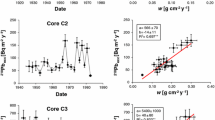Abstract
A large seabird colony of northern fulmars (Fulmarus glacialis) at Cape Vera on Devon Island in the Canadian high Arctic has been shown to act as an effective biological pump, transporting large quantities of marine-derived nutrients and contaminants to the ponds beneath their nesting sites. Previous research has shown that seabirds also have the potential to elevate radionuclide concentrations in their immediate surroundings. Here, we assess the influence of the Cape Vera seabird colony on the 210Pb budgets of six affected ponds and one control site, and discuss potential implications with respect to 210Pb dating methodologies. In general, fluxes of 210Pb at Cape Vera were similar to, or less than, those measured at other Arctic locations not influenced by seabirds. Plots of unsupported 210Pb activity versus depth showed a number of non-monotonic features in all sediment cores, necessitating the use of the constant-rate-of-supply (CRS) model to derive age-depth profiles. We conclude that seabird activity has not dramatically increased the 210Pb flux to the ponds at Cape Vera. Overall, the low flux of excess 210Pb made accurate dating problematic for some of the study cores, necessitating the use of independent dating markers (e.g., 137Cs and PCB concentrations) to verify the reliability of the chronologies.


Similar content being viewed by others
References
Appleby PG (2001) Chronostratigraphic techniques in recent sediments. In: Last WM, Smol JP (eds) Tracking environmental change using lake sediments. Volume 1: Basin analysis, coring, and chronological techniques. Kluwer Acadamic Publishers, Dordrecht, The Netherlands, pp 172–203
Binford MW, Kahl JS, Norton SA (1993) Interpretation of 210Pb profiles and verification of the CRS dating model in the PIRLA project lake sediment cores. J Paleolimnol 9:275–296
Blais JM, Muir DCG (2001) Paleolimnological methods and applications for organic contaminants. In: Last B, Smol JP (eds) Developments in paleoenvironmental research, vol 2: physical and chemical approaches, chap 10. Kluwer Academic Press, Dordrecht, The Netherlands, pp 271–298
Blais JM, Kalff J, Cornett RJ, Evans RD (1995) Evaluation of 210Pb dating in lake sediments using stable Pb, Ambrosia pollen, and 137Cs. J Paleolimnol 13:169–178
Blais JM, Kimpe LE, McMahon D, Keatley B, Mallory ML, Douglas MSV, Smol JP (2005) Arctic seabirds transport marine-derived contaminants. Science 309:445. doi:10.1126/science.1112658
Blais JM, MacDonald RW, Mackay D, Webster E, Harvey C, Smol JP (2007) Biologically mediated transport of contaminants to aquatic systems. Environ Sci Technol 41:1075–1084
Douglas MSV, Smol JP, Blake W Jr (1994) Marked post-18th century environmental change in high-arctic ecosystems. Science 266:416–419
Dowdall M, Gwynn JP, Gabrielsen GW, Lind B (2005) Assessment of elevated radionuclide levels in soils associated with an avian colony in a high arctic environment. Soil Sediment Contam 14:1–11
Fitzgerald WF, Engstrom DR, Lamborg CH, Tseng C-M, Balcom PH, Hammerschmidt CR (2005) Modern and historic atmospheric mercury fluxes in northern Alaska: global sources and Arctic depletion. Environ Sci Technol 39:557–568
Gaston AJ, Mallory ML, Gilchrist HG, O’Donovan K (2006) Status, trends and attendance patterns of the northern fulmar Fulmarus glacialis in Nunavut, Canada. Arctic 59:165–178
Glew JR (1988) A portable extruding device for close interval sectioning of unconsolidated core samples. J Paleolimnol 1:235–239
Glew JR (1989) A new trigger mechanism for sediment samplers. J Paleolimnol 2:241–243
Hermanson MH (1990) 210Pb and 137Cs chronology of sediments from small, shallow Arctic lakes. Geochim Cosmochim Acta 1443–1451
Keatley BE (2007) Limnological and paleolimnological investigations of environmental change in three distinct ecosystem types, Canadian High Arctic. PhD Thesis, Queen’s University at Kingston, Ontario, Canada, 332 pp
Krümmel EM, Gregory-Eaves I, Macdonald RW, Kimpe LE, Demers MJ, Smol JP, Finney B, Blais JM (2005) Concentrations and fluxes of salmon–derived polychlorinated biphenyls (PCBs) in lake sediments. Environ Sci Technol 39:7020–7026
Lockhart WL, Wilkinson P, Billeck BN, Danell RA, Hunt RV, Brunskill GJ, Delaronde J, St Louis V (1998) Fluxes of mercury to lake sediments in central and northern Canada inferred from dated sediment cores. Sci Total Environ 260:171–180
Lockhart WL, Stern G, Outridge P (2000) Mercury and other contaminants in a laminated sediment core from Devon Island. In: Kalhok S (ed) Synopsis of research carried out under the 1999–2000 northern contaminants program. Dept. of Indian Affairs and Northern Development, Ottawa, Canada, pp 104–112
Michelutti N, Wolfe AP, Vinebrooke RD, Rivard B, Briner J (2005) Recent primary production increases in arctic lakes. Geophys Res Lett 32:L19715. doi: 10.1029/2005GL023693
Michelutti N, Wolfe AP, Briner JP, Miller GH (2007) Climatically controlled chemical and biological development in Arctic lakes. J Geophys Res 112:G03002. doi:10.1029/2006JG000396
Schottler SP, Engstrom DR (2006) A chronological assessment of Lake Okeechobee (Florida) sediments using multiple dating markers. J Paleolimnol 36:19–36
Wolfe AP, Miller GH, Olsen CA, Forman SL, Doran PT, Holmgren SU (2004) Geochronology of high latitude lake sediments. In: Pienitz R, Douglas MSV, Smol JP (eds) Long-term environmental change in Arctic and Antarctic Lakes. Springer, The Netherlands, pp 19–52
Acknowledgements
This work was funded by Strategic and Discovery grants from the Natural Science and Engineering Research Council of Canada awarded to JMB, MSVD, and JPS, and a Northern Scientific Training Program (NSTP) grant to BEK. We thank the Polar Continental Shelf Project/Étude du Plateau Continental Polaire (PCSP/ÉPCP), NSTP and Environment Canada (CWS) for financial and logistical support in the field. The quality of this manuscript was greatly improved by two anonymous reviewers. This represents PCSP/ÉPCP contribution No. 03207.
Author information
Authors and Affiliations
Corresponding author
Rights and permissions
About this article
Cite this article
Michelutti, N., Blais, J.M., Liu, H. et al. A test of the possible influence of seabird activity on the 210Pb flux in high Arctic ponds at Cape Vera, Devon Island, Nunavut: implications for radiochronology. J Paleolimnol 40, 783–791 (2008). https://doi.org/10.1007/s10933-008-9198-2
Received:
Accepted:
Published:
Issue Date:
DOI: https://doi.org/10.1007/s10933-008-9198-2




